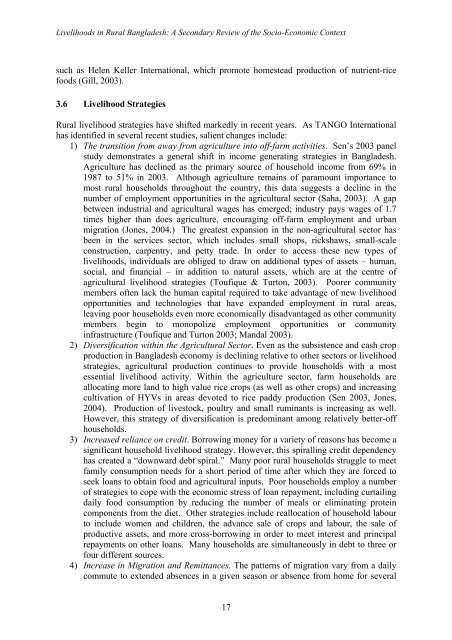RURAL BANGLADESH - PreventionWeb
RURAL BANGLADESH - PreventionWeb
RURAL BANGLADESH - PreventionWeb
Create successful ePaper yourself
Turn your PDF publications into a flip-book with our unique Google optimized e-Paper software.
Livelihoods in Rural Bangladesh: A Secondary Review of the Socio-Economic Context<br />
such as Helen Keller International, which promote homestead production of nutrient-rice<br />
foods (Gill, 2003).<br />
3.6 Livelihood Strategies<br />
Rural livelihood strategies have shifted markedly in recent years. As TANGO International<br />
has identified in several recent studies, salient changes include:<br />
1) The transition from away from agriculture into off-farm activities. Sen’s 2003 panel<br />
study demonstrates a general shift in income generating strategies in Bangladesh.<br />
Agriculture has declined as the primary source of household income from 69% in<br />
1987 to 51% in 2003. Although agriculture remains of paramount importance to<br />
most rural households throughout the country, this data suggests a decline in the<br />
number of employment opportunities in the agricultural sector (Saha, 2003). A gap<br />
between industrial and agricultural wages has emerged; industry pays wages of 1.7<br />
times higher than does agriculture, encouraging off-farm employment and urban<br />
migration (Jones, 2004.) The greatest expansion in the non-agricultural sector has<br />
been in the services sector, which includes small shops, rickshaws, small-scale<br />
construction, carpentry, and petty trade. In order to access these new types of<br />
livelihoods, individuals are obliged to draw on additional types of assets – human,<br />
social, and financial – in addition to natural assets, which are at the centre of<br />
agricultural livelihood strategies (Toufique & Turton, 2003). Poorer community<br />
members often lack the human capital required to take advantage of new livelihood<br />
opportunities and technologies that have expanded employment in rural areas,<br />
leaving poor households even more economically disadvantaged as other community<br />
members begin to monopolize employment opportunities or community<br />
infrastructure (Toufique and Turton 2003; Mandal 2003).<br />
2) Diversification within the Agricultural Sector. Even as the subsistence and cash crop<br />
production in Bangladesh economy is declining relative to other sectors or livelihood<br />
strategies, agricultural production continues to provide households with a most<br />
essential livelihood activity. Within the agriculture sector, farm households are<br />
allocating more land to high value rice crops (as well as other crops) and increasing<br />
cultivation of HYVs in areas devoted to rice paddy production (Sen 2003, Jones,<br />
2004). Production of livestock, poultry and small ruminants is increasing as well.<br />
However, this strategy of diversification is predominant among relatively better-off<br />
households.<br />
3) Increased reliance on credit. Borrowing money for a variety of reasons has become a<br />
significant household livelihood strategy. However, this spiralling credit dependency<br />
has created a “downward debt spiral.” Many poor rural households struggle to meet<br />
family consumption needs for a short period of time after which they are forced to<br />
seek loans to obtain food and agricultural inputs. Poor households employ a number<br />
of strategies to cope with the economic stress of loan repayment, including curtailing<br />
daily food consumption by reducing the number of meals or eliminating protein<br />
components from the diet. Other strategies include reallocation of household labour<br />
to include women and children, the advance sale of crops and labour, the sale of<br />
productive assets, and more cross-borrowing in order to meet interest and principal<br />
repayments on other loans. Many households are simultaneously in debt to three or<br />
four different sources.<br />
4) Increase in Migration and Remittances. The patterns of migration vary from a daily<br />
commute to extended absences in a given season or absence from home for several<br />
17












![View full document [PDF 988.55 KB] - PreventionWeb](https://img.yumpu.com/47733942/1/184x260/view-full-document-pdf-98855-kb-preventionweb.jpg?quality=85)
![View full document (in French) [PDF 4.96 MB] - PreventionWeb](https://img.yumpu.com/47223870/1/184x260/view-full-document-in-french-pdf-496-mb-preventionweb.jpg?quality=85)


![View full document [PDF 25.02 MB] - PreventionWeb](https://img.yumpu.com/44204570/1/190x234/view-full-document-pdf-2502-mb-preventionweb.jpg?quality=85)
